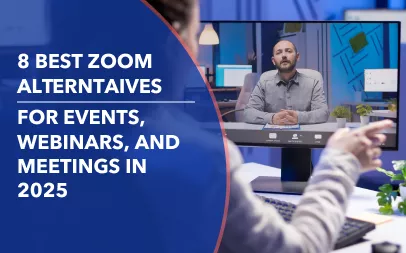
A live webinar refers to a web-based seminar or online presentation that allows participants to interact with the presenter and other attendees in real-time. Unlike traditional seminars or conferences, which require physical attendance, webinars can be accessed from anywhere with an internet connection. They have become increasingly popular in today's digital age due to their convenience and ability to reach a larger audience.
Understanding the Concept of a Webinar
In order to fully grasp the meaning of a live webinar, it is important to understand its evolution and key features. Webinars have emerged as a result of advancements in technology and the need for more efficient ways of sharing knowledge and information. They have revolutionized the way we learn, teach, and conduct business.
The Evolution of Webinars
Webinars have come a long way since their inception. Initially, they were limited to audio presentations with accompanying slides. However, with the advent of video conferencing and screen sharing technologies, webinars now offer a more immersive and engaging experience. Participants can now see and hear the presenter in real-time, making the learning process more interactive and dynamic.
Moreover, webinars have evolved from being one-way communication platforms to fostering collaboration and interaction among participants. Features such as chat boxes, polls, and Q&A sessions enable attendees to actively engage with the presenter and each other, creating a virtual classroom or meeting environment.
As webinars continue to evolve, new technologies and features are constantly being integrated. For example, some webinars now offer virtual reality (VR) capabilities, allowing participants to have a more immersive and realistic experience. This technology can transport attendees to virtual environments where they can interact with objects and engage in hands-on learning activities.
Key Features of a Webinar
There are several key features that distinguish a webinar from other forms of online content. Firstly, webinars are live events that occur at a specific date and time. This creates a sense of urgency and encourages attendees to participate in real-time. Additionally, webinars are usually recorded, allowing those who couldn't attend the live event to access the content at a later time.
Furthermore, webinars often incorporate multimedia elements such as videos, slideshows, and interactive activities to enhance the learning experience. These features help to keep participants engaged and promote better retention of information. In fact, studies have shown that incorporating multimedia elements in webinars can significantly improve knowledge retention compared to traditional lecture-style presentations.
Moreover, webinars offer the convenience of remote learning or participation. Attendees can join a webinar from anywhere in the world as long as they have an internet connection. This eliminates the need for travel and accommodation expenses, making webinars a cost-effective option for both organizers and participants.
Lastly, webinars typically have a specific goal or objective, whether it's to educate, train, sell a product, or build brand awareness. Organizers carefully plan the content and structure of the webinar to ensure that it aligns with the intended purpose. This goal-oriented approach helps to deliver focused and impactful presentations that meet the needs and expectations of the target audience.
In conclusion, webinars have evolved from simple audio presentations to immersive and interactive learning experiences. They offer a range of features and benefits that make them an effective tool for sharing knowledge and information. Whether you're a student, professional, or business owner, webinars provide a convenient and engaging way to learn, collaborate, and stay up-to-date with the latest industry trends.
Distinguishing Between Live and Pre-Recorded Webinars
While both live and pre-recorded webinars serve their own purposes, there are distinct differences between the two that are worth exploring.
The Uniqueness of Live Webinars
Live webinars offer a unique experience that cannot be replicated with pre-recorded content. The real-time interaction between the presenter and participants creates a sense of immediacy and engagement. Attendees can ask questions, seek clarification, and receive answers in real-time, making the learning experience more personalized and interactive.
Moreover, the live nature of webinars allows for spontaneous discussion and collaboration among participants. This fosters a sense of community and encourages networking opportunities that may not be possible with pre-recorded webinars.
Imagine joining a live webinar on digital marketing. As the presenter discusses various strategies and techniques, you find yourself inspired to ask a question about social media advertising. With live webinars, you have the opportunity to type your question into the chatbox and have it answered by the presenter, right then and there. This real-time interaction not only helps you clarify your doubts but also allows you to engage with the presenter and other participants, creating a dynamic learning environment.
Furthermore, live webinars often include interactive elements such as polls, quizzes, and surveys. These features enable presenters to gauge the audience's understanding and gather valuable feedback, enhancing the overall learning experience. By actively participating in these interactive activities, attendees can test their knowledge, gain insights from others, and feel more connected to the topic being discussed.
Advantages of Pre-Recorded Webinars
While live webinars have their merits, there are situations where pre-recorded webinars may be more suitable. Pre-recorded webinars offer flexibility in terms of scheduling and availability. Participants can access the content at their own convenience, making it ideal for those with busy schedules or in different time zones.
Additionally, pre-recorded webinars provide the opportunity for more polished and refined presentations. Presenters have the advantage of editing their content, ensuring that it is concise, error-free, and visually appealing. This can result in a more professional and streamlined delivery, enhancing the overall learning experience.
Imagine having a pre-recorded webinar on project management. The presenter has carefully crafted the content, removing any unnecessary tangents and ensuring that the information is presented in a logical and organized manner. As a participant, you can follow along at your own pace, pausing and rewinding as needed to fully grasp the concepts being discussed. This flexibility allows you to absorb the material at a comfortable pace, ensuring a deeper understanding of the subject matter.
Moreover, pre-recorded webinars often come with supplementary resources such as downloadable PDFs, worksheets, or additional reading materials. These resources can further enhance the learning experience by providing participants with extra materials to reinforce their understanding or delve deeper into specific topics.
It is important to note that pre-recorded webinars can still offer a level of interactivity. While participants may not have the opportunity to ask live questions, many pre-recorded webinars provide contact information or discussion forums where attendees can reach out to the presenter or engage with other participants.
In conclusion, both live and pre-recorded webinars have their own unique advantages. Live webinars provide real-time interaction, spontaneity, and community-building opportunities, while pre-recorded webinars offer flexibility, polished presentations, and supplementary resources. The choice between the two ultimately depends on the specific needs and preferences of the participants and the goals of the webinar itself.
Like what you see?
Inspired to take your webinars and virtual events to the next level? Unlock the full potential with Remo's cutting-edge platform Elevate your gatherings with Remo's dynamic features. Sign up today and embark on a journey of unforgettable connections and growth! Book a demo today!




























